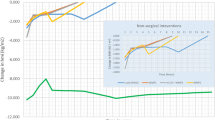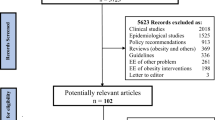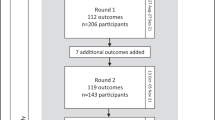Abstract
Objective:
To report on a new modelling approach developed for the assessing cost-effectiveness in obesity (ACE-Obesity) project and the likely population health benefit and strength of evidence for 13 potential obesity prevention interventions in children and adolescents in Australia.
Methods:
We used the best available evidence, including evidence from non-traditional epidemiological study designs, to determine the health benefits as body mass index (BMI) units saved and disability-adjusted life years (DALYs) saved. We developed new methods to model the impact of behaviours on BMI post-intervention where this was not measured and the impacts on DALYs over the child's lifetime (on the assumption that changes in BMI were maintained into adulthood). A working group of stakeholders provided input into decisions on the selection of interventions, the assumptions for modelling and the strength of the evidence.
Results:
The likely health benefit varied considerably, as did the strength of the evidence from which that health benefit was calculated. The greatest health benefit is likely to be achieved by the ‘Reduction of TV advertising of high fat and/or high sugar foods and drinks to children’, ‘Laparoscopic adjustable gastric banding’ and the ‘multi-faceted school-based programme with an active physical education component’ interventions.
Conclusions:
The use of consistent methods and common health outcome measures enables valid comparison of the potential impact of interventions, but comparisons must take into account the strength of the evidence used. Other considerations, including cost-effectiveness and acceptability to stakeholders, will be presented in future ACE-Obesity papers. Information gaps identified include the need for new and more effective initiatives for the prevention of overweight and obesity and for better evaluations of public health interventions.
This is a preview of subscription content, access via your institution
Access options
Subscribe to this journal
Receive 12 print issues and online access
$259.00 per year
only $21.58 per issue
Buy this article
- Purchase on Springer Link
- Instant access to full article PDF
Prices may be subject to local taxes which are calculated during checkout

Similar content being viewed by others
References
International Food Information Council. Trends in obesity related media coverage. 2006 (accessed August 2006); Available from: http://www.ific.org/research/obesitytrends.cfm.
Lobstein T, Baur L, Uauy R . Obesity in children and young people: a crisis in public health. Obes Rev 2004; 5 (Suppl 1): 4–104.
Gold MR, Siegel JE, Russell LB, Weinstein MC (eds). Cost-Effectiveness in Health and Medicine. Oxford University Press: New York, 1996.
Vos T, Haby MM, Magnus A, Mihalopoulos C, Andrews G, Carter R . Assessing cost-effectiveness in mental health: helping policy-makers prioritize and plan health services. Aust NZ J Psychiatry 2005; 39: 701–712.
Swinburn B, Gill T, Kumanyika S . Obesity prevention: a proposed framework for translating evidence into action. Obes Rev 2005; 6: 23–33.
Doak CM, Visscher TL, Renders CM, Seidell JC . The prevention of overweight and obesity in children and adolescents: a review of interventions and programmes. Obes Rev 2006; 7: 111–136.
Summerbell CD, Waters E, Edmunds LD, Kelly S, Brown T, Campbell KJ . Interventions for preventing obesity in children (Cochrane review). Cochrane Database of Systematic Reviews 2005; Art No.: CD001871.
Segal L, Mortimer D, Dalziel K . Risk factor study: how to reduce the burden of harm from poor nutrition, tobacco smoking, physical inactivity and alcohol misuse: cost-utility analysis of 29 interventions, executive report. Research Paper 2005 (1). Centre for Health Economics, Monash University: Melbourne 2005.
Wang LY, Yang Q, Lowry R, Wechsler H . Economic analysis of a school-based obesity prevention program. Obes Res 2003; 11: 1313–1324.
Carter R, Stone C, Vos T, Hocking J, Mihalopoulos C, Peacock S et al. Trial of Program Budgeting and Marginal Analysis (PBMA) to assist cancer control planning in Australia, Research Report 19. Centre for Health Program Evaluation: Melbourne, 2000.
Liew D, Lim SS, Bertram M, McNeil JJ, Vos T . A model for undertaking effectiveness and cost-effectiveness analyses of primary preventive strategies in cardiovascular disease. Eur J Cardiovasc Prevent Rehab 2006; 13: 515–522.
Haby MM, Carter R, Mihalopoulos C, Magnus A, Sanderson K, Andrews G et al. Assessing cost-effectiveness – mental health: introduction to the study and methods. Aust NZ J Psychiatry 2004; 38: 569–578.
Carter R . The Macro Economic Evaluation Model (MEEM): an approach to priority setting in the health sector (PhD thesis). Monash University: Melbourne, 2001.
Avenell A, Broom J, Brown TJ, Poobalan A, Aucott L, Stearns SC et al. Systematic review of the long-term effects and economic consequences of treatments for obesity and implications for health improvement. Health Technol Assess 2004; 8 (21): 1–194.
James WPT, Jackson-Leach R, Mhurchu CN, Kalamara E, Shayeghi M, Rigby NJ et al. Overweight and obesity (high body mass index). In: Ezzati M, Lopez AD, Rodgers A, Murray CJL (eds). Comparative Quantification of Health Risks: Global and Regional Burden of Disease Attributable to Selected Major Risk Factors. Geneva: World Health Organization, 2004. pp 497–596.
National Obesity Taskforce. Healthy Weight 2008 – Australia's Future – The National Action Agenda for Children and Young People and their Families. Department of Health and Ageing: Canberra, 2003.
Australian Government. Active After-School Communities Program. 2005 (accessed 20 August 2006); Available from: http://www.healthyactive.gov.au/internet/healthyactive/publishing.nsf/Content/initiatives-a.
Mo-suwan L, Pongprapai S, Junjana C, Puetpaiboon A . Effects of a controlled trial of a school-based exercise program on the obesity indexes of preschool children. Am J Clin Nutr 1998; 68: 1006–1011.
Sallis JF, McKenzie TL, Alcaraz JE, Kolody B, Hovell MF, Nader PR . Project SPARK. Effects of physical education on adiposity in children. Ann NY Acad Sci 1993; 699: 127–136.
Dwyer T, Coonan WE, Leitch DR, Hetzel BS, Baghurst RA . An investigation of the effects of daily physical activity on the health of primary school students in South Australia. Int J Epidemiol 1983; 12: 308–313.
Tamir D, Feurstein A, Brunner S, Halfon ST, Reshef A, Palti H . Primary prevention of cardiovascular diseases in childhood: changes in serum total cholesterol, high density lipoprotein, and body mass index after 2 years of intervention in Jerusalem schoolchildren age 7–9 years. Prev Med 1990; 19: 22–30.
Manios Y, Moschandreas J, Hatzis C, Kafatos A . Evaluation of a health and nutrition education program in primary school children of Crete over a three-year period. Prev Med 1999; 28: 149–159.
Foster GD, Wadden TA, Brownell KD . Peer-led program for the treatment and prevention of obesity in the schools. J Consult Clin Psychol 1985; 53: 538–540.
James J, Thomas P, Cavan D, Kerr D . Preventing childhood obesity by reducing consumption of carbonated drinks: cluster randomised controlled trial. Br Med J 2004; 328: 1237–1243.
Ebbeling CB, Feldman HA, Osganian SK, Chomitz VR, Ellenbogen SJ, Ludwig DS . Effects of decreasing sugar-sweetened beverage consumption on body weight in adolescents: a randomized, controlled pilot study. Pediatrics 2006; 117: 673–680.
Robinson TN . Reducing children's television viewing to prevent obesity: a randomized controlled trial. JAMA 1999; 282: 1561–1567.
Gortmaker SL, Peterson K, Wiecha J, Sobol AM, Dixit S, Fox MK et al. Reducing obesity via a school-based interdisciplinary intervention among youth: Planet Health. Arch Pediatr Adolesc Med 1999; 153: 409–418.
DiPietro G, Hughes I . TravelSMART Schools – there really is a better way to go. 26th Australasian Transport Research Forum; Wellington, New Zealand; 2003. Available from: http://www.travelsmart.vic.gov.au/Web4/tsmart.nsf/.
VicHealth. Walking School Bus. 2006 (accessed 20 August 2006); Available from: http://www.vichealth.vic.gov.au/Content.aspx?topicID=23.
Victoria University. The Walking School Bus Program. Learnings from VicHealth's pilot program 2001. VicHealth: Melbourne, 2003.
Gorn G, Golberg M . Behavioural evidence of the effects of televised food messages to children. J Consum Res 1982; 9: 200–205.
McCallum Z, Wake M, Gerner B, Harris C, Gibbons K, Gunn J et al. Can Australian general practitioners tackle childhood overweight/obesity? Methods and processes from the LEAP (Live, Eat and Play) randomized controlled trial. J Paediatr Child Health 2005; 41: 488–494.
Flodmark CE, Ohlsson T, Ryden O, Sveger T . Prevention of progression to severe obesity in a group of obese schoolchildren treated with family therapy. Pediatrics 1993; 91: 880–884.
Israel AC, Stolmaker L, Andrian CAG . The effects of training parents in general child management skills in a behavioural weight loss program for children. Behav Ther 1985; 16: 169–180.
Kirschenbaum DS, Harris ES, Tomarken AJ . Effects of parental involvement in behavioural weight loss therapy for preadolescents. Behav Ther 1984; 15: 485–500.
Senadiak CSS . Rapid versus gradual scheduling of therapeutic contact in a family-based behavioural weight control programme for children. Behav Psychother 1985; 13: 265–287.
Chanoine JP, Hampl S, Jensen C, Boldrin M, Hauptman J . Effect of orlistat on weight and body composition in obese adolescents: a randomized controlled trial. JAMA 2005; 293: 2873–2883.
Abu-Abeid S, Gavert N, Klausner JM, Szold A . Bariatric surgery in adolescence. J Pediatr Surg 2003; 38: 1379–1382.
Avinoah E . Laparoscopic gastric banding for morbidly obese adolescents. Surg Laparosc Endosc Percutaneous Tech 2004; 14: 350.
Fielding GA, Duncombe JE . Laparoscopic adjustable gastric banding in severely obese adolescents. Surg Obes Relat Dis 2005; 1: 399–405.
Hayr T, Widhalm K . Laparoscopic gastric banding in morbidly obese adolescents. Ann Nutr Metab 2003; 47: 427.
Widhalm K, Dietrich S, Prager G . Adjustable gastric banding surgery in morbidly obese adolescents: experiences with eight patients. Int J Obes 2004; 28: S42–S45.
Mathers C, Vos T, Stevenson C . The burden of disease and injury in Australia. AIHW cat. no. PHE 18. Australian Institute of Health and Welfare: Canberra 1999. (also available at) http://www.aihw.gov.au/publications/.
Public Health Group. Victorian Burden of Disease Study: Mortality and Morbidity in 2001. Department of Human Services: Melbourne, 2005.
Deeks JJ, Altman DG, Bradburn MJ . Statistical methods for examining heterogeneity and combining results from several studies in meta-analysis. In: Egger M, Smith GD, Altman DG (eds). Systematic Reviews in Health Care: Meta-Analysis in Context 2nd edn. BMJ Publishing Group: London, 2001. pp 285–312.
Swinburn BA, Jolley D, Kremer PJ, Salbe AD, Ravussin E . Estimating the effects of energy imbalance on changes in body weight in children. Am J Clin Nutr 2006; 83: 859–863.
Rolls BJ . The role of energy density in the overconsumption of fat. J Nutr 2000; 130: 268S–271S.
Rolls BJ, Roe LS, Meengs JS . Reductions in portion size and energy density of foods are additive and lead to sustained decreases in energy intake. Am J Clin Nutr 2006; 83: 11–17.
Cook P, Rutishauser IHE, Seelig M . Comparable Data on Food and Nutrient Intake and Physical Measurements from the 1983, 1985 and 1995 National Nutrition Surveys. Commonwealth Department of Health and Aged Care: Canberra, 2001.
McLennan W . Australian Bureau of Statistics. Information paper: National Nutrition Survey, confidentialised unit record file, 1995. Australian Bureau of Statistics: Canberra, 1998.
Bell AC, Kremer PJ, Magarey AM, Swinburn BA . Contribution of ‘noncore’ foods and beverages to the energy intake and weight status of Australian children. Eur J Clin Nutr 2005; 59: 639–645.
Australian Department of Health & Ageing. Australian Guide to Healthy Eating. Australian Department of Health & Ageing: Canberra, 1998.
Ludwig DS, Peterson KE, Gortmaker SL . Relation between consumption of sugar-sweetened drinks and childhood obesity: a prospective, observational analysis. Lancet 2001; 357: 505–508.
Ainsworth BE, Haskell WL, Whitt MC, Irwin ML, Swartz AM, Strath SJ et al. Compendium of physical activities: an update of activity codes and MET intensities. Med Sci Sports Exerc 2000; 32: S498–S504.
Ezzati M, Lopez AD, Rodgers A, Vander Hoorn S, Murray CJ . Selected major risk factors and global and regional burden of disease. Lancet 2002; 360: 1347–1360.
Vos T, Goss J, Begg S, Mann N . Australian Burden of Disease and Injury Study: Projected Health Care Costs Report. School of Population Health, University of Queensland and Australian Institute of Health and Welfare: Brisbane, 2005.
National Health and Medical Research Council. A Guide to the Development, Implementation and Evaluation of Clinical Practice Guidelines. NHMRC: Canberra, 1999.
Hawe P, Shiell A . Preserving innovation under increasing accountability pressures: the health promotion investment portfolio approach. Health Promot J Aust 1995; 5: 4–9.
NHMRC National Breast Cancer Centre Psychosocial Working Group. Psychosocial Clinical Practice Guidelines: Information, Support and Counselling for Women with Breast Cancer. National Health and Medical Research Council: Canberra, 2000.
Loxley W, Toumbourou JW, Stockwell T . The Prevention of Substance use, Risk and Harm in Australia: A Review of the Evidence. The National Drug Research Institute and the Centre for Adolescent Health: Canberra, 2004.
Rychetnik L, Frommer M . A Schema for Evaluating Evidence on Public Health Interventions; Version 4. National Public Health Partnership: Melbourne, 2002.
World Bank. World Development Report 1993: Investing in Health. Oxford University Press: New York, 1993.
Ezzati M, Lopez AD, Rodgers A, Murray CJL (eds). Comparative Quantification of Health Risks: Global and Regional Burden of Disease Attributable to Selected Major Risk Factors. World Health Organization: Geneva, 2004.
Rose G . Sick individuals and sick populations. Int J Epidemiol 1985; 14: 32–38.
McMahon SK, Haynes A, Ratnam N, Grant MT, Carne CL, Jones TW et al. Increase in type 2 diabetes in children and adolescents in Western Australia. Med J Aust 2004; 180: 459–461.
Acknowledgements
We thank members of the ACE-Obesity working group for their input into the project: Michael Ackland (Deputy Chair), Bill Bellew, John Catford, Elizabeth Develin, Helen Egan, Bonnie Field, Tim Gill, John Goss, Robert Hall (Chair), Brian Harrison, Kellie-Ann Jolly, Mark Lawrence, Amanda Lee, Tony McBride, Karen McIntyre, Jan Norton, Anna Peeters, Melissa Wake and Rowland Watson. We also thank the other researchers who have worked on the project as part of their postgraduate studies: Jaithri Ananthapavan, Leah Galvin, Margaret MacDonald and Margaret Rumpf.
Author information
Authors and Affiliations
Corresponding author
Rights and permissions
About this article
Cite this article
Haby, M., Vos, T., Carter, R. et al. A new approach to assessing the health benefit from obesity interventions in children and adolescents: the assessing cost-effectiveness in obesity project. Int J Obes 30, 1463–1475 (2006). https://doi.org/10.1038/sj.ijo.0803469
Received:
Revised:
Accepted:
Published:
Issue Date:
DOI: https://doi.org/10.1038/sj.ijo.0803469
Keywords
This article is cited by
-
Components in downstream health promotions to reduce sugar intake among adults: a systematic review
Nutrition Journal (2024)
-
Primary prevention programs for childhood obesity: are they cost-effective?
Italian Journal of Pediatrics (2023)
-
Modelling health and economic impact of nutrition interventions: a systematic review
European Journal of Clinical Nutrition (2023)
-
Economic analysis of three interventions of different intensity in improving school implementation of a government healthy canteen policy in Australia: costs, incremental and relative cost effectiveness
BMC Public Health (2018)
-
Protocol for a systematic review of methods and cost-effectiveness findings of economic evaluations of obesity prevention and/or treatment interventions in children and adolescents
Systematic Reviews (2018)



